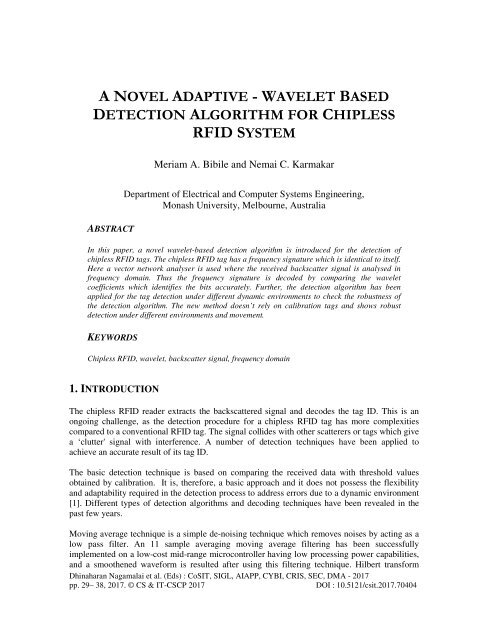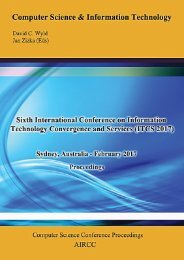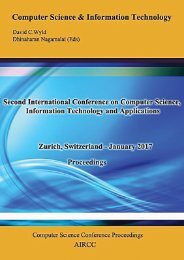CoSIT 2017
Fourth International Conference on Computer Science and Information Technology ( CoSIT 2017 ), Geneva, Switzerland - March 2017
Fourth International Conference on Computer Science and Information Technology ( CoSIT 2017 ), Geneva, Switzerland - March 2017
You also want an ePaper? Increase the reach of your titles
YUMPU automatically turns print PDFs into web optimized ePapers that Google loves.
A NOVEL ADAPTIVE - WAVELET BASED<br />
DETECTION ALGORITHM FOR CHIPLESS<br />
RFID SYSTEM<br />
Meriam A. Bibile and Nemai C. Karmakar<br />
ABSTRACT<br />
Department of Electrical and Computer Systems Engineering,<br />
Monash University, Melbourne, Australia<br />
In this paper, a novel wavelet-based detection algorithm is introduced for the detection of<br />
chipless RFID tags. The chipless RFID tag has a frequency signature which is identical to itself.<br />
Here a vector network analyser is used where the received backscatter signal is analysed in<br />
frequency domain. Thus the frequency signature is decoded by comparing the wavelet<br />
coefficients which identifies the bits accurately. Further, the detection algorithm has been<br />
applied for the tag detection under different dynamic environments to check the robustness of<br />
the detection algorithm. The new method doesn’t rely on calibration tags and shows robust<br />
detection under different environments and movement.<br />
KEYWORDS<br />
Chipless RFID, wavelet, backscatter signal, frequency domain<br />
1. INTRODUCTION<br />
The chipless RFID reader extracts the backscattered signal and decodes the tag ID. This is an<br />
ongoing challenge, as the detection procedure for a chipless RFID tag has more complexities<br />
compared to a conventional RFID tag. The signal collides with other scatterers or tags which give<br />
a ‘clutter' signal with interference. A number of detection techniques have been applied to<br />
achieve an accurate result of its tag ID.<br />
The basic detection technique is based on comparing the received data with threshold values<br />
obtained by calibration. It is, therefore, a basic approach and it does not possess the flexibility<br />
and adaptability required in the detection process to address errors due to a dynamic environment<br />
[1]. Different types of detection algorithms and decoding techniques have been revealed in the<br />
past few years.<br />
Moving average technique is a simple de-noising technique which removes noises by acting as a<br />
low pass filter. An 11 sample averaging moving average filtering has been successfully<br />
implemented on a low-cost mid-range microcontroller having low processing power capabilities,<br />
and a smoothened waveform is resulted after using this filtering technique. Hilbert transform<br />
Dhinaharan Nagamalai et al. (Eds) : <strong>CoSIT</strong>, SIGL, AIAPP, CYBI, CRIS, SEC, DMA - <strong>2017</strong><br />
pp. 29– 38, <strong>2017</strong>. © CS & IT-CSCP <strong>2017</strong><br />
DOI : 10.5121/csit.<strong>2017</strong>.70404





